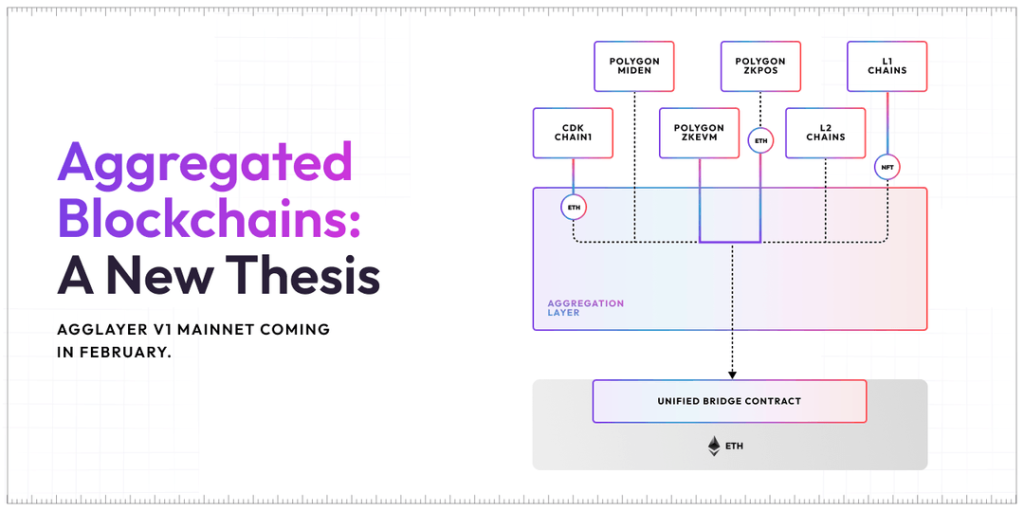KEY TAKEAWAYS
- Polygon Labs is gearing up to launch AggLayer, a protocol designed to simplify multi-blockchain networks.
- AggLayer will allow users to interact with various blockchains as if they were a single entity.
- The protocol will enable seamless transactions across different blockchain platforms without the need for bridging.
- AggLayer combines the strengths of both monolithic and modular blockchain designs.
- A continual upgrade path is outlined for AggLayer, with a significant update already in the pipeline for later this year.
Polygon Labs, a prominent player in the blockchain industry, is on the verge of rolling out AggLayer, a new protocol that promises to streamline the user experience across multiple blockchain networks.
With a scheduled launch next month, AggLayer is positioned to provide an environment that offers the convenience of a single chain to its end-users.
Simplified Cross-Chain Interaction
AggLayer, aiming to present a network that operates with the simplicity and cohesion of a single chain, will use zero-knowledge proofs (ZK-proofs) to aggregate data from various blockchains.
This innovative approach allows developers to integrate layer 1 and layer 2 blockchains, merging them into a cohesive network.
The result is an experience for users that’s akin to the everyday use of the internet, marked by ease and efficiency.

Enhancing User Experience
The introduction of AggLayer will benefit users significantly. The protocol eliminates the need for constant and complex bridges between different blockchains, making the process of interacting with decentralized applications (dApps) much smoother.
Users will no longer need to be aware of the underlying processes involved in accessing another chain, fostering an improved experience and greater accessibility.
Real-World Applications Made Simple
To illustrate the utility of AggLayer, consider a user on an Ethereum layer-2 chain X1, who holds Dai and wishes to purchase a nonfungible token on Polygon’s zero-knowledge Ethereum Virtual Machine (zkEVM).
With AggLayer, the user doesn’t need to bridge their Dai to the zkEVM in advance. From their perspective, the process is as straightforward as dealing with a single chain, allowing them to interact with dApps effortlessly, without the need to understand the complexities of chain interactions.
The Evolution of Blockchain Structures
AggLayer is not just another addition to the blockchain space; it’s an evolution. Traditional monolithic blockchains like Bitcoin process everything from transactions to data availability within a single layer, which can lead to limitations in scalability.
Modular blockchains, such as post-merge Ethereum, distribute these functions across multiple layers to address these issues.
AggLayer takes the best of both worlds, enhancing the integrated and modular architectures through the use of ZK technology, which leads to improved efficiency and scalability.
Looking Ahead
Polygon Labs isn’t stopping at the initial launch of AggLayer in February. Plans for a second iteration of the protocol later in the year are already in motion.
This version will support cross-chain transactions without both chains needing to be online at the same time.
As Polygon Labs continues the development and refinement of the AggLayer protocol, their goal remains steadfast: to forge a unified, highly scalable network that brings together the diverse world of blockchains.
LATEST POSTS
- Exploring the Cutting Edge Trends of Bitcoin Gaming: An Intersection of Tech, Entertainment, and Digital Currency
- Banking Experts Shift to Crypto Employment
- Verpex Review: Unveiling the Pros and Cons of This Hosting Provider
- Nexo AG Files $3 Billion Arbitration Claim Against Bulgaria
- TOP 12 Day Trading Crypto Books For Beginners
- Nigerian Crypto Startups Seek Regulatory Approval Amidst Market Changes
Previous Articles:
- Exploring the Cutting Edge Trends of Bitcoin Gaming: An Intersection of Tech, Entertainment, and Digital Currency
- Banking Experts Shift to Crypto Employment
- Verpex Review: Unveiling the Pros and Cons of This Hosting Provider
- Nexo AG Files $3 Billion Arbitration Claim Against Bulgaria
- TOP 12 Day Trading Crypto Books For Beginners
